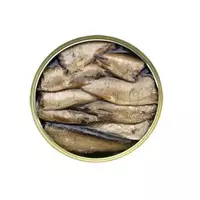Canned sprat

Canning is a well-known way around the world to preserve the distinctive taste and consumer characteristics of food for a longer period of time. In the process of preservation, the initial plant or raw materials of animal origin undergo thermal treatment, as a result of which microorganism contributing to the natural process of food spoilage is destroyed.
It can be said that the main task of the preservation process is to reduce the biological activity of microorganisms contained in any food product. Canning is a whole range of measures that are aimed at the so-called isolation of food products from bacteria contained in their composition, as well as spores. The main preservation processes include the following:
fermentation or process of food preservation with the help of acids and special culinary marinades;
pickling is a preservation process in which the product is subjected with organic acids to an acidic environment unsuitable for the development and life of bacteria;
candyrvoicing or sugaring is suitable for harvesting fruits or candied fruits;
salting, as a rule, is used for canning fish and meat food products.
Canned fish have a special place in the diet of the vast majority of the inhabitants of planet Earth. In the global culinary tradition, canned fish has found more than widespread use and distribution. Many types of culinary products are made on the basis of canned fish.
In addition, canned fish can act as an independent food product. Usually canned fish is used in the process of making salads, soups, snacks, sandwiches or tartlets. In addition, on the basis of canned fish, excellent tasty and healthy fillings for home baking are obtained. Canned sprat enjoys special honor among the inhabitants of our latitudes.
Sprat is a common name for a number of fish species belonging to the Herring family. Sprats and tulip fish are considered sprats. Sprats are small in size, but are not inferior in the content of useful compounds to other larger representatives of the family. As a rule, several main types of canned sprats are found on sale:
pickled sprat;
salted sprat;
spicy salty sprat;
canned sprats in tomato sauce;
canned sprats in vegetable oil;
smoked canned sprats.
Canned sprats in tomato sauce and salted sprats are in particular demand. Canned sprats of any type can be purchased in a ready-to-use form in domestic grocery stores. You can make canned sprats at home. Although some effort will have to be made to cook tasty canned sprats at home, still even the highest quality version of a mass-produced product cannot be compared to home blanks.
tinned sprats 88 kCal
Energy value of canned sprats (Ratio of proteins, fats, carbohydrates - ju):
Proteins: 17.5 (~ 70 kCal)
Fats: 2.2 g (~ 20 kCal)
Carbohydrates: 0 g (~ 0 kCal)
Energy ratio (b | y): 80% | 23% | 0%
 Español
Español Français
Français Português
Português Русский
Русский 简体中文
简体中文 繁體中文
繁體中文 日本語
日本語 한국어
한국어 العربية
العربية Türkçe
Türkçe Қазақ
Қазақ Deutsch
Deutsch Italiano
Italiano Українська
Українська
